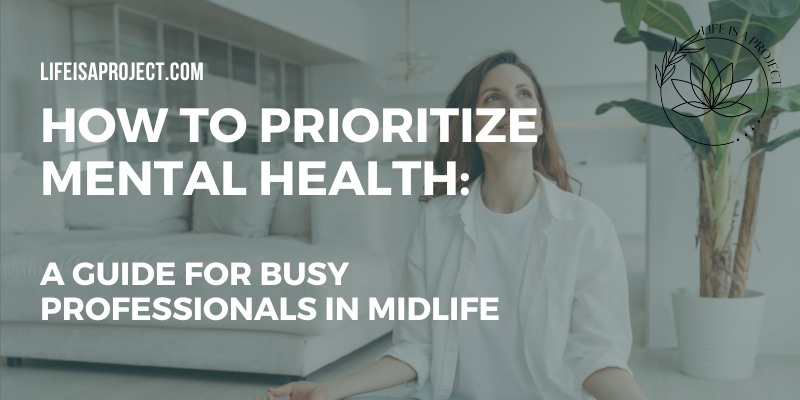Hey there! If you’re navigating the whirlwind of midlife with a career, family, and a packed schedule, you’re likely juggling a lot—and mental health can easily slip down the priority list. It’s all too common to focus on getting things done, often at the expense of your own well-being. But here’s the truth: prioritizing mental health isn’t a luxury; it’s essential.
Just like you schedule meetings, projects, and appointments, making time for your mental well-being is an absolute must, especially during the busy midlife years. Let’s explore practical tips for recognizing and managing mental health challenges, and how to carve out space for yourself amidst the chaos.
The Reality: Mental Health in Midlife
Midlife can be a time of significant transition. You might be climbing the career ladder, managing kids or aging parents, or dealing with the physical and emotional changes that come with getting older. It’s a stage of life that brings its own set of pressures and stressors, which can take a toll on your mental health if left unchecked.
Common signs that your mental health might need attention include:
- Chronic Stress or Anxiety: Feeling overwhelmed, constantly on edge, or unable to relax.
- Mood Changes: Experiencing persistent sadness, irritability, or a lack of interest in activities you used to enjoy.
- Sleep Issues: Struggling with insomnia, waking up frequently, or feeling exhausted despite getting enough sleep.
- Physical Symptoms: Frequent headaches, muscle tension, or other unexplained aches and pains.
- Difficulty Concentrating: Trouble focusing on tasks, making decisions, or feeling mentally foggy.
Recognizing these signs is the first step. The next step is taking action to prioritize your mental health, even when life is busy. Here’s how.
Practical Tips for Prioritizing Mental Health
1. Acknowledge Your Stressors
The first step to managing your mental health is to acknowledge what’s causing you stress or discomfort. It might be work pressures, family responsibilities, financial concerns, or even health issues.
- How to Do It: Take a few moments each day to check in with yourself. Identify specific stressors and how they’re impacting you. Sometimes, just naming what’s on your mind can help you start to feel more in control.
- Quick Tip: Use a journal or an app like Daylio to track your mood and identify patterns or triggers that affect your mental well-being.
2. Set Boundaries
Boundaries are essential for protecting your mental health. Without them, it’s easy to overextend yourself, leading to burnout and resentment.
- How to Do It: Start by setting small boundaries around your time and energy. This might mean saying “no” to extra work commitments, setting limits on your availability, or carving out specific times of the day that are just for you.
- Quick Tip: Practice saying “no” without guilt. Remember, every “yes” to something that doesn’t serve you is a “no” to something that does.
3. Make Time for Self-Care
Self-care is not selfish; it’s a necessity. It doesn’t have to be elaborate or time-consuming—simple, consistent actions can make a big difference in your mental well-being.
- How to Do It: Schedule self-care activities into your day, just like you would any other important appointment. This could be a morning walk, reading a book, meditating, or enjoying a cup of tea without distractions.
- Quick Tip: Try the “5-5-5” method: Spend 5 minutes each day on your mind (e.g., meditation), 5 minutes on your body (e.g., stretching), and 5 minutes on something you enjoy (e.g., listening to music).
4. Stay Connected
Social connections are a powerful buffer against stress and anxiety. Even when you’re busy, making time for meaningful interactions can significantly boost your mood and overall mental health.
- How to Do It: Prioritize quality over quantity when it comes to social interactions. A short, genuine conversation with a friend or loved one can be more fulfilling than endless small talk.
- Quick Tip: Use technology to stay connected if in-person meetups are challenging. A quick video call, a heartfelt text, or even sharing a funny meme can help maintain those bonds.
5. Practice Mindfulness and Meditation
Mindfulness and meditation are effective tools for reducing stress and enhancing mental clarity. They help you stay present and reduce the tendency to get caught up in worries about the future or regrets about the past.
- How to Do It: Start with just 5 minutes a day. Focus on your breathing, notice your surroundings, or use a guided meditation app like Calm or Headspace.
- Quick Tip: Incorporate mini-mindfulness moments throughout your day, like taking a few deep breaths before starting a new task or savoring your morning coffee mindfully.
6. Prioritize Sleep
Sleep is the foundation of mental health, yet it’s often the first thing we sacrifice when life gets busy. Good sleep hygiene can improve your mood, concentration, and overall resilience.
- How to Do It: Establish a calming bedtime routine, keep your sleep environment cool and dark, and aim for 7-9 hours of quality sleep each night. Avoid screens at least an hour before bed to improve sleep quality.
- Quick Tip: If you struggle with falling asleep, try a relaxation technique like progressive muscle relaxation or deep breathing exercises before bed.
7. Seek Professional Support When Needed
It’s okay to ask for help. If you’re struggling with persistent stress, anxiety, or depression, seeking support from a mental health professional can provide valuable tools and insights.
- How to Do It: Reach out to a therapist, counselor, or support group that resonates with you. Many professionals offer flexible scheduling, including virtual sessions, which can fit more easily into a busy lifestyle.
- Quick Tip: Explore platforms like BetterHelp or Talkspace for convenient access to therapy.
Overcoming Common Mental Health Challenges
Even with the best intentions, prioritizing mental health can be challenging, especially when you’re juggling so much. Here’s how to tackle some common obstacles:
- “I don’t have time.” Start small. Even dedicating just 5 minutes a day to a mental health practice can make a difference. Gradually increase the time as it becomes a habit.
- “I feel guilty taking time for myself.” Remember that taking care of your mental health isn’t just for you—it benefits everyone around you. When you’re mentally well, you’re better equipped to handle your responsibilities and support those you care about.
- “I don’t know where to start.” Begin by acknowledging how you feel. Pick one or two tips from this guide and try them out. The key is to start somewhere and build from there.
Conclusion: Making Mental Health a Priority
Prioritizing your mental health doesn’t mean you have to overhaul your entire life or add more to your already busy schedule. It’s about small, intentional actions that help you feel more balanced, resilient, and equipped to handle whatever comes your way. Whether it’s setting boundaries, practicing mindfulness, or simply taking a few minutes to breathe, these small steps can have a big impact on your overall well-being.
So, take a moment to check in with yourself today. What’s one small thing you can do to support your mental health? Here’s to embracing self-care, setting boundaries, and making your mental well-being a top priority—because you deserve it.



